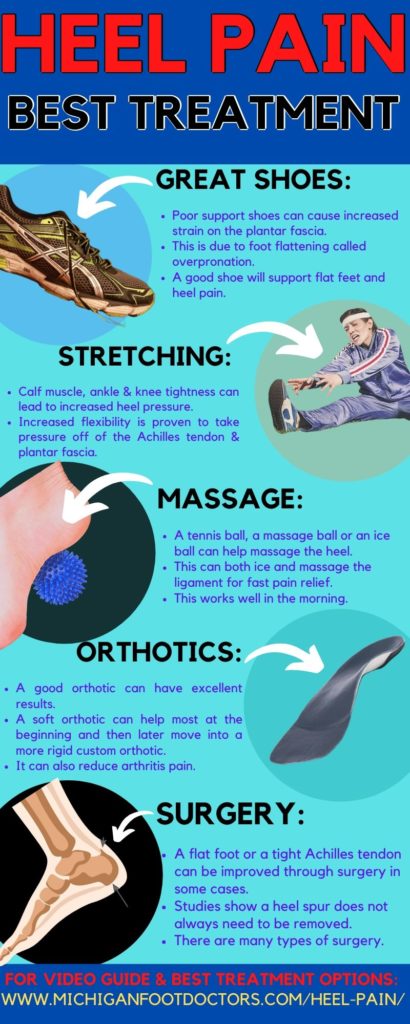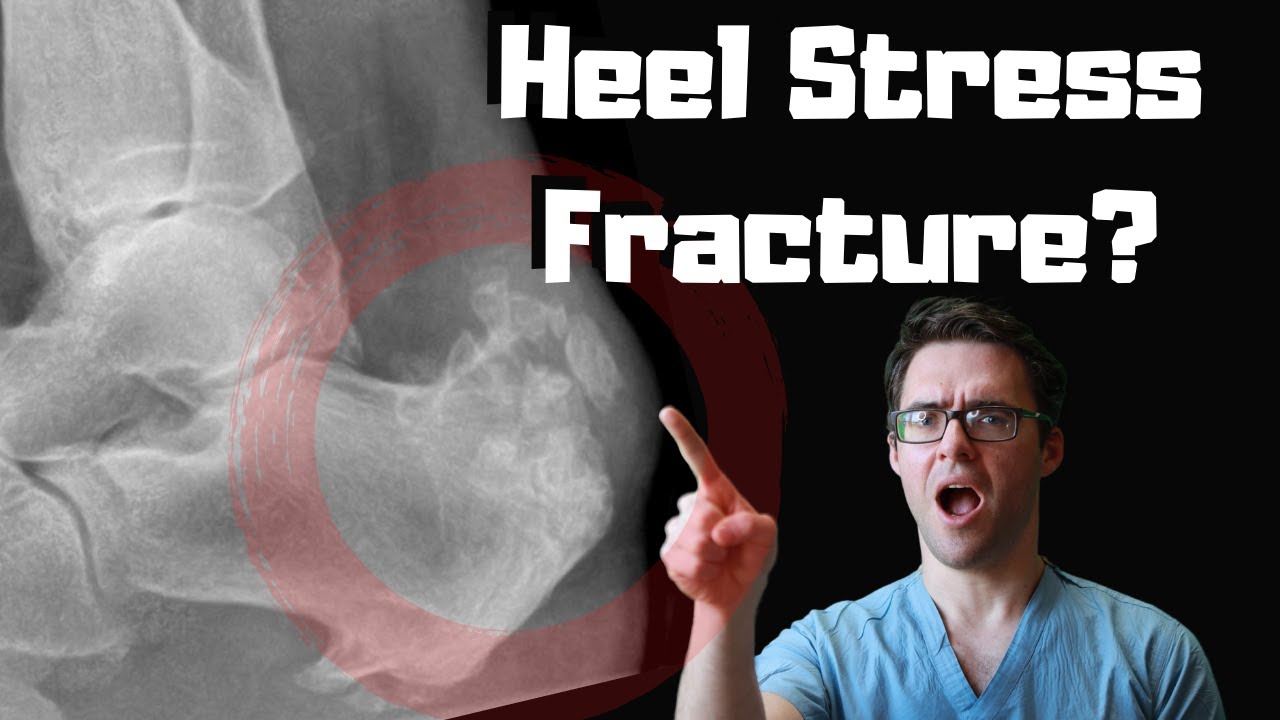Stress Fracture of the Calcaneus [Symptoms, Causes & BEST Treatment]
Stress Fracture of the Calcaneus – This pain gets worse the more you walk on it and is due to overworking your heel bone. Find out how to fix it FAST!
Table of Contents
Calcaneus Stress Fracture Treatment Video:
Calcaneus Stress Fracture Pain Causes:
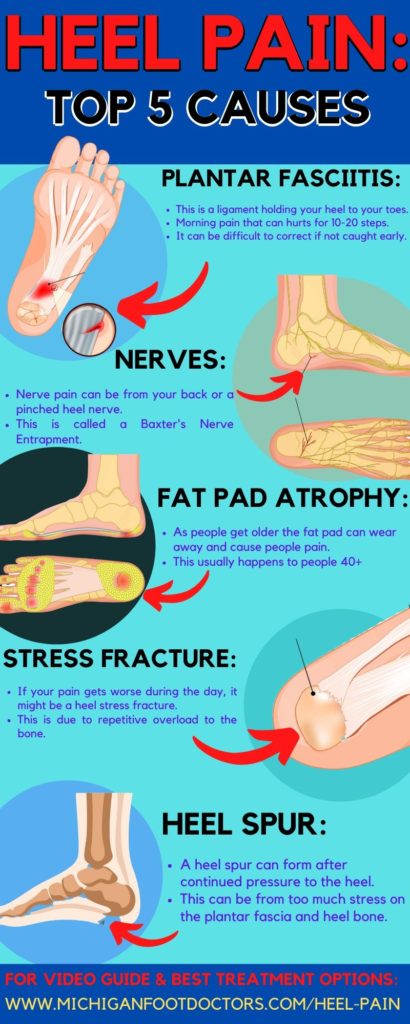
Heel Pain Causes: Picture & Photo Gallery
Look:
- One of the top causes of heel pain is plantar fasciitis. This is damage to a ligament that holds your heel to your toes.
- Another root cause of heel pain has flat feet.
- There are also photos of heel spurs that can occur to the bottom of your heel (plantar fascia insertion) and the back of your heel (Achilles tendon insertion).
- Baxter’s nerve entrapment can also happen at the bottom of the heel.
- An underlying cause is an overpronated flatfoot or an over a supinated high arched foot.
- A plantar fibroma is a thick nodule that can occur within your plantar fascia ligament and contribute to plantar fasciitis.
- This can lead to the formation of a heel stress fracture( AKA calcaneus stress fracture.)
Please click on the gallery for a guided tour through heel pain conditions!
Causes:
- Stress fractures occur as a cycle of repetitive loading and unloading of the bone and are not the result of a weak bone or any other systemic illness like osteoporosis!
- People who develop stress fractures can be described as weekend warriors or people who start to take on too much of an activity too quickly after not preparing themselves properly.
- This would include people who went from not walking to walking many miles per day or someone who just started training very hard for a marathon after not really running before.
- If the patient has diabetes or decreased nerve function, this raises the possibility of a neuropathic fracture due to a lack of feeling and sensation in that area of the heel.
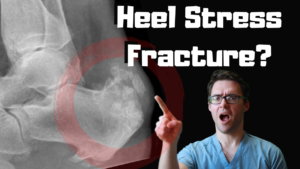
Symptoms:
Do you have a heel stress fracture? These symptoms are what it will feel like:
- The pain does get worse while standing during the day.
- The pain is worse with less supportive shoes.
- The pain is worse without orthotics.
- The heel hurts when you squeeze it from side to side.
- The heel may hurt when squeezing from the bottom to the top.
- It is less likely if the pain is worse in the morning and if the pain is felt through the Achilles tendon.
Diagnosis:
- Diagnosis of a stress fracture of the heel bone is based upon listening to the prior history, which usually includes an increased activity.
- The most common stress fracture site is just inferior and posterior to the posterior sub-talar joint facet of the calcaneus.
- The calcaneus stress fracture can be confirmed by compressing the heel and causing pain, especially on the outside of the heel.
- Swelling, warmth, and tenderness should be present in that area.
- Studies have shown that compression pain of the heel with surrounding swelling, warmth, and tenderness of the heel bone is very accurate in suggesting a stress fracture in the calcaneus.
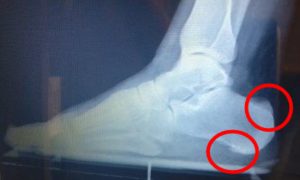
Calcaneal stress fracture squeeze test:
- this can be an effective way to make sure you don’t have plantar fasciitis or just Achilles tendinitis.
- Squeezing the calcaneus from side to side makes it more likely to feel pain if you have a calcaneal stress fracture.
- It is more likely to be plantar fasciitis if your pain is at the bottom of the foot.
- It is more likely to be Achilles tendinitis if your pain is in the back of the heel or along the Achilles tendon.
Imaging:
- X-ray is good to detect a stress fracture, but it is difficult to locate one in the first 10-14 days of the stress fracture occurrence.
- The most sensitive initial scan is a technetium bone scan or MRI. The only problem with these is that they are a little bit more difficult and expensive to administer.
- An X-ray is usually a good enough diagnosis tool if combined with the compression test and signs of inflammation in the heel bone.
- After 2-3 weeks, the X-ray will show a thickened white line in the stress fracture area as it begins to remodel itself.
Healing Time of a Stress Fracture of the Calcaneus:
- Healing time of two months or so until the pain has gone away; the stress fracture of the calcaneus almost always heals in the correct position.
- The options below will help you start feeling better faster!
Recovery Time:
- The heel stress fracture can take a very long time to heal.
- The most common problem we see is that people continue to put pressure and weight on their calcaneus, not truly giving it a chance to heal.
- For this reason, on average, we see people require about six weeks to get 50% of the final result.
- Six weeks to get about 75% of the final result,
- About six months to get to about 95% of the final result.
- 1 year to get to 100% of the final result.
Calcaneal Stress Fracture Surgery:
- Calcaneal stress fractures generally do not need surgery.
- A stress fracture is different than a true calcaneal fracture because there is no displacement.
- This means surgery is usually not needed to be approximate any displaced bone edges.
- If this was a true traumatic injury, you should see your podiatrist or to the emergency room as soon as possible to have your foot and ankle evaluated.
- A calcaneal stress fracture is a severe injury, and this can take many months to heal.
- There is also a very high percentage chance of long-term subtalar joint arthritis resulting from a calcaneal stress fracture with displacement.
Calcaneus Stress Fracture Prevention:
The stress fracture will eventually heal on its own if you keep weight off it, but you can do these things to make it heal faster and prevent one from ever coming back.
- Immobilization in a CAM walker.
- Anti-inflammatory medication.
- Cryotherapy.
- Transition into a stiff-soled shoe.
- Lose weight.
- Biomechanical evaluation.
- OTC orthotics.
- Stretching exercises.
Other Treatments That May Help:
- Consider our comprehensive plantar fasciitis heel pain guide.
- If you are having Achilles tendon pain as well, there is a good chance you might be having plantar fasciitis pain to the bottom of your foot.
Calcaneus stress fracture treatment:
